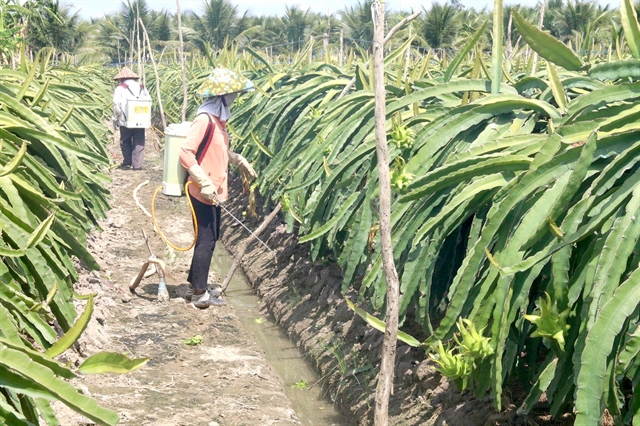 Society
Society

The Cửu Long (Mekong) Delta province of Tiền Giang, the country's largest fruit producer, is expanding its dragon fruit growing area as part of its agricultural restructuring and climate-change adaptation plans.

|
| Farmers tend dragon fruit in Tiền Giang Province’s Chợ Gạo District. — VNA/VNS Photo Minh Trí |
TIỀN GIANG — The Cửu Long (Mekong) Delta province of Tiền Giang, the country's largest fruit producer, is expanding its dragon fruit growing area as part of its agricultural restructuring and climate-change adaptation plans.
Tiền Giang has nearly 10,000ha of dragon fruit. Of the specialised dragon fruit area of 7,400ha in Chợ Gạo District, more than 5,200 ha have yielded an annual output of 162,000 tonnes.
Dragon fruit, one of the province’s key specialty fruits, has competitive advantages and can adapt to climate change.
Ngô Hữu Tuệ, secretary of the Chợ Gạo District Party Committee, said to improve quality and competitiveness at home and abroad, the district has encouraged farmers to grow the fruit under Vietnamese good agricultural practices (VietGAP) standards.
Last year, the province granted VietGAP certificates for 1,118ha of dragon fruit in the district, taking the district’s total VietGAP dragon fruit area to 2,180ha, up 9.2 per cent of the target set for last year.
Dương Thanh Tám, who grows a 0.9ha red-flesh dragon fruit orchard in Chợ Gạo’s Tân Thuận Bình Commune, said that under VietGAP standards, farmers use mainly biological pesticides and organic fertilisers.
Instead of using concrete posts to grow dragon fruits under traditional growing methods, Tám uses trellises, which offer higher yield and quality.
He earns a profit of VNĐ600 million (US$26,000) a year from his orchard.
Many rice farmers in the district have switched to growing GAP-standard dragon fruit and have joined agricultural co-operatives to secure outlets for their produce.
Lê Văn Thuỷ in Chợ Gạo’s Mỹ Tịnh An Commune said he turned his 1ha unproductive rice field into dragon fruit using Global GAP standards, and joined the Mỹ Tịnh An Dragon Fruit Co-operative.
Thuỷ has also used advanced farming techniques like irrigation spraying and electric lamps at night to stimulate growth in order to produce off-season fruits that sell at higher prices.
Thuỷ and other co-operative members have been trained in farming techniques under VietGAP and Global GAP standards. Their cost of registering for VietGAP and Global GAP certificates is also subsidised.
Thuỷ has a farm contract with outlets which ensures a minimum price of VNĐ10,000 a kilogramme. He earns nearly VNĐ1 billion ($43,400) a year from growing the fruit under Global GAP standards.
“The profit is more than 10 times higher than from high-quality rice,” he said.
The price of off-season dragon fruit is normally three times higher than the price of main season dragon fruit. Off-season red-flesh dragon yielded an average profit of VNĐ300 million ($13,000) per hectare a crop for farmers. The off-season harvest of dragon fruit lasts between November and April.
The district’s dragon fruit was awarded a collective brand name “Thanh long Chợ Gạo” by the National Office of Intellectual Property.
The district’s dragon fruit has been exported to many markets, including the EU and the US.
Targets
Chợ Gạo District plans to expand its specialised dragon fruit growing area to more than 7,500ha by the end of this year.
It also plans to have an additional 500ha of dragon fruit granted VietGAP certificates this year, taking the district’s total VietGAP area to 2,684ha by the end of this year.
The district will provide VietGAP standard farming techniques to about 1,800 farmers this year, and strengthen linkages between farmers and buyers.
The district has nearly 9,400ha of various types of fruits, including dragon fruit, and green-skin and pink-flesh grapefruit. — VNS




